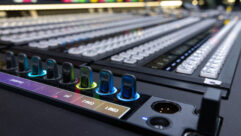
Technology Showcase: HD Servers
Oct 1, 2004 12:00 PM,
By Brent Harshbarger
Accom WSD/HDe
High definition (HD) is here. The major television networks and cable networks have committed to HDTV and are delivering HD content already. The HDV format, which records to standard MiniDV tape, was introduced during NAB 2004, and the new versions of most major video-editing software programs support both standard definition (SD) and HD. Therefore, there are now HD formats to suit directors of major motion pictures all the way down to prosumer videographers. HD content will soon be everywhere (for more about HD content, see “Picture This” on p. 24).
Okay, so you aren’t in the business of creating major motion pictures, and you don’t have a showroom where you can peddle prosumer products. This article focuses, then, on the storage and presentation of HD material for markets such as retail, education, museums, sports venues, themed venues, transportation, and houses of worship. Most video-oriented installation projects allow the end-user to create great audiovisual experiences based on preproduced content. Preproduced content has to be stored and accessed easily. Video servers, then, can play a large role in the delivery of those audiovisual experiences.

Leitch Nexio
Many systems integrators are looking for playback systems for video, and they know that any new projects should support HD. Before you can properly select an HD server or storage device, you will need to know what formats the server will be required to support. HD’s larger frame sizes mean, of course, that significantly more storage is required to serve an hour of HD material than a comparable SD clip would need. Each HD format has a direct correlation to the necessary amount of storage and bandwidth and the type of decoder required. The baseline elements that make up high-definition video include resolution, compression (if any), frame rate, and whether the scanning is interlaced or progressive. The two fundamental resolutions are 1920 by 1080 and 1280 by 720. Format names end with a letter that designates whether the format is interlaced or progressive scan. Typical formats, then, are 1080i, 1080p, 720i, and 720p, and each of those can have frame rates of 24 or 30 frames per second (or 60 interlaced fields per second). HD supports various audio technologies, including mono, stereo, and 5.1 surround sound.
VIDEO SERVER ELEMENTS
The basic building blocks of video servers are server software and a hardware platform to run it on, storage, and a method to get video in and out of the system. There also needs to be some type of control element capable of searching, creating a playlist, and performing basic start, stop, pause, play, and record functions.
Video servers come in all shapes and sizes, from fixed all-in-one boxes to large-scale systems that operate across a network. The management, scale, and playout of the servers are the variables that determine which video server is right for which job. Servers can be categorized into three basic system types: all in one, server with attached storage, and multiple servers with multiple storage systems.

Doremi Labs V1 HD
All-in-one servers come in a variety of form factors, but all are completely self-contained, with the server and storage in the same package. Companies such as Daktronics and Barco provide small servers that are built into some of the monitors. On the other hand, Alcorn McBride’s Digital Video Machine HD is a simple, straightforward server without a monitor, and Doremi Labs offers HD servers in form factors that resemble those of traditional video recorders.
Storage attached servers are found in traditional video production and playout applications. Companies that have been in this field for several years include Accom, Pinnacle Systems, and Leitch, and there are newcomers in this area, as well. Streaming servers fall into this general category, too. Whereas traditional servers output video via analog or serial digital interface connections, streaming servers stream data via Internet protocol (IP), and some type of decoder is necessary at the user’s end.
Large server systems require a more flexible approach. Multiple servers might need to access one or more storage systems. The number of players at this end of the market is relatively small, but that should change in the near future. Large deployment of this type is predominately in the form of systems based on a storage area network, in which the storage is seen as just another network device.
VIDEO FLOW

MagicBox Aavelin HD
Getting video into and out of a video server requires more today than just a video jack on the back. There are two methods of working with HD storage and servers. The first involves ingesting the video signal into the system through some type of stream. That could be from an HD camera with IEEE-1394 output or some other device with a digital connection. Although you can work with uncompressed HD video, that is rarely practical. HD is associated with several compression schemes. It can be encoded and stored in an MPEG-2, an MPEG-4, a Windows Media 9, or a QuickTime file, just to name a few. The second method involves transferring the complete HD video file (compressed or not) across a TCP/IP network. Both methods might be implemented in a single application.
TAKE CONTROL OF HD
For HD servers to be fully useful, they require the ability to communicate with other devices, whether in the same system or in remote locations. Most systems today come standard with RS-422 and TCP/IP control, and some offer GPI control. The systems that support the production environment typically have tape machine — like controls that allow you to punch in the video clip to be played out and to jog through the video.
An increasingly important aspect of control is the ability to view the videos on the server from a remote device or location and to create and edit a playlist. Even for the all-in-one servers, remote software is often available.
THE HD CASH FLOW
Advertising agencies are looking for new ways to get their clients’ messages out. Traditional television advertising is becoming more fragmented, and the infamous cost-per-thousand just isn’t what it use to be. One potential answer is the rebirth of the billboard business in a new and exciting form. Electronic signage with local information and national advertising should continue to grow rapidly during the next few years, and HD will be a driving force behind it. That, of course, is promising news for systems integrators.

Omneon Spectrum ES
Many all-in-one servers are designed to support changing the playlists and video content from remote locations across a data network. Demand for this functionality could be a significant driver of the industry’s growth during the next five years. Companies moving toward this technology include Daktronics, Barco, Sony, Alcorn McBride, Adtec, MagicBox, and C-nario.
ESPN and Turner are moving quickly to produce sports fully in HD. Once fans start to see their favorite teams’ logos in full HD on television, they will want to see them at the stadiums and arenas. (Some stadiums and arenas, most notably Madison Square Garden, have been displaying HD content for years.) And you can bet the beverage companies will want to see their logo animations in full HD, too. This is one growing application for the wide range of all-in-one HD server boxes.
Moving to larger-scale systems, houses of worship soon will take advantage of HD. A few early adopters have already embraced the promise of HD production. Many houses of worship will trade DVD and videotape playout schemes for video servers during their next round of system improvements. Content providers such as Artbeats already have extensive HD footage intended for use in religious venues as backdrops to enhance worship music. With the advent of both the HDV format and cost-effective ways of editing HD video with 5.1 surround sound, HD presentation is the next logical step.
Houses of worship will benefit from server systems with attached storage for both production playback during the worship services and for streaming the services over the Internet. For these applications, companies like Apple, Accom, Doremi Labs, Leitch, and Pinnacle Systems have many flexible solutions for system integrators.
HD servers are widely available from very small, playback-only devices to large network-based systems. With standard-definition video and tape-based playback systems on the wane, HD servers give system integrators a solid growth path for the future.
Brent Harshbargerhas worked for Peavey in the development of MediaMatrix. He can be reached at[email protected].
For More Information
Accom
www.accom.com
Adtec
www.adtecinc.com
Alcorn McBride
www.alcornmcbride.com
Apple
www.apple.com
Barco
www.barco.com
C-nario
www.c-nario.com
Chyron
www.chyron.com
Daktronics
www.daktronics.com
Doremi Labs
www.doremilabs.com
DVS
www.dvs.de
Enseo
www.enseo.com
Leitch
www.leitch.com
MagicBox
www.magicboxinc.com
Microsoft
www.microsoft.com/windows/windowsmedia
Omneon Video Networks
www.omneon.com
Pinnacle Systems
www.pinnaclesys.com
SeaChange International
www.seachangeinternational.com
Sony
www.sony.com
Thomson Grass Valley
www.thomsongrassvalley.com










